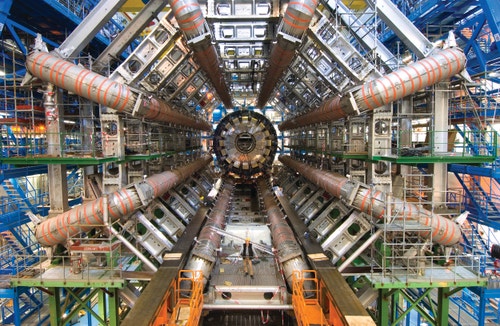Physicists Discover New Subatomic Particle
Monday, July 20th, 2015July 20, 2015
Physicists have added another type of subatomic particle to the so-called “particle zoo” of quantum mechanics: the pentaquark. This rare, fleeting particle is—as its name implies—made of five smaller particles, called quarks. Physicists at the Large Hadron Collider announced the discovery on July 14, though it was based on detailed measurements taken years earlier during the collider’s atom-smashing operations.

Huge and complex particle accelerators have greatly expanded our understanding of the science of physics. This photograph shows a particle detector at an accelerator called the Large Hadron Collider (LHC). Physicists at the LHC recently announced the discovery of the pentaquark. (© Maximilien Brice, CERN)
Quarks are elementary particles—that is, pieces of matter that do not seem to consist of anything smaller. Instead, quarks form building blocks for larger particles, called hadrons. Protons and neutrons are two types of hadrons, each containing three quarks. Protons and neutrons, in turn, form the nuclei (cores) of atoms. To understand how small quarks are, consider that atoms are already far too small to see with the naked eye. Then consider that the inside of an atom is almost entirely empty space. If a hydrogen atom were 4 miles (6 kilometers) wide, the single proton inside its nucleus would be the size of a tennis ball. Such is the scale of hadrons and the quarks they contain.
Three-quark hadrons—like protons and neutrons—are called baryons. Mesons are another type of hadron, consisting of just two quarks. Scientists have observed almost three hundred distinct types of hadrons, but until recently, all of these hadrons seem to have contained just two or three quarks. Scientists had predicted that five-quark hadrons—pentaquarks—could exist, theoretically. Now they have experimental proof.
Protons and neutrons are the only stable types of hadrons. All other known types of hadrons, once created, tend to disintegrate within a few hundred-millionths of a second. This difficulty, along with the fact that hadrons are so vanishingly small, makes measuring their presence difficult. But the Large Hadron Collider, based at the CERN organization in Switzerland, was specially built for this task. It accelerates hadrons around an underground ring 17 miles (27 miles) in circumference, causing them to travel at nearly the speed of light. At such speeds, collisions between even the tiniest objects are inevitable over time. New types of hadrons, like pentaquarks and other unstable particles, are created in the debris of such collisions. By carefully and accurately measuring signals from the collisions, and observing the patterns over time, physicists have been able to detect the presence of many new types of particles.
In 2012, physicists at the Large Hadron Collider announced they had found evidence for the Higgs boson, a particle believed to give other particles their mass. The discovery of pentaquarks, while not as earth-shattering as that of the Higgs boson, helps flesh out our understanding of how matter behaves at the smallest scales.
Other World Book articles:



